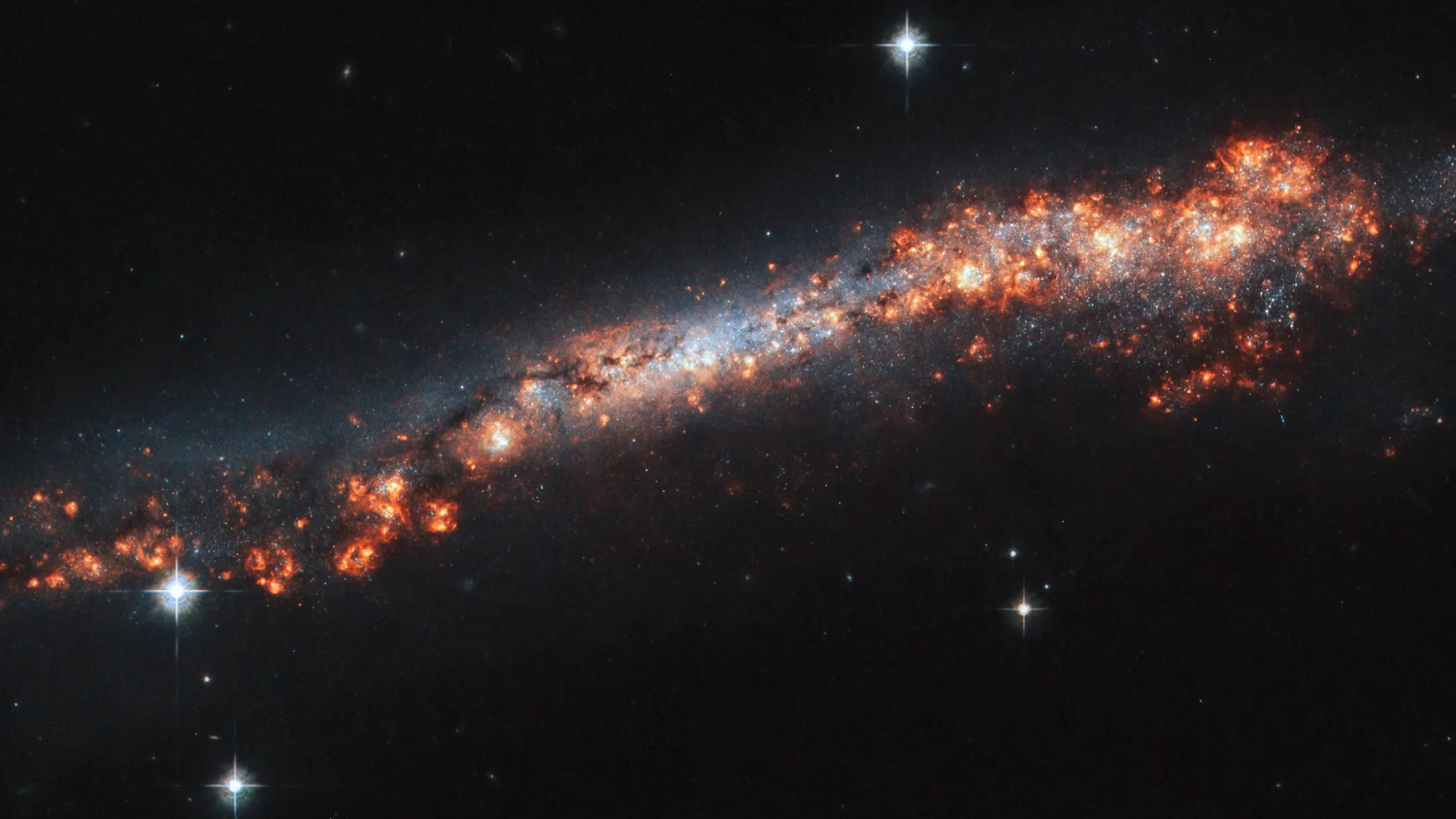NC Space Grant Congratulates 2024-2025 Student Competition Teams

SeaWolf IX in action. Photo Credit: Abhi Poosarla
North Carolina Space Grant (NC Space Grant) congratulates twelve student teams that competed in the 2024-2025 national competitions either sponsored or sanctioned by NASA or another science technology, engineering, and math (STEM) related organization or industry. These teams tackled STEM challenges, including navigating autonomously through obstacle courses to launching and retrieving rocket payloads.
“As the competitions get more challenging each year, it is important that our student teams learn from their success and their challenges. These competitions are not easy. Exposure to the engineering design process, that includes testing and anomalies, is an important element of the engineering design process. This is where the learning happens both technically and professionally,” said Sandy Canfield, assistant director for NC Space Grant.
Some highlights from this year include a new team from Campbell University that competed in the new remote controlled (RC) division of the NASA Human Rover Challenge. Additionally, a team from Duke University participated in the Spaceport America Cup alongside a reappearance from the team from Lenoir-Rhyne University.
Competitions must provide students with hands-on experiential learning opportunities related to one or more of NASA’s Mission Directorates. Team members within different majors, departments, and/or with skills such as fundraising and marketing, communications and social media, and education and outreach are also encouraged to participate.
“The experience provided through the Team Experience and Competition awards enables students to gain essential professional teamwork skills necessary for workforce development,” Canfield added. “Furthermore, students share their work through outreach events at colleges and universities, as well as at middle and high schools, to ignite the interests of the next generation of explorers.”
NC Space Grant commends these teams for their collaboration and success in this year’s competitions.
NASA Student Launch Competition
NASA Student Launch (SL) is one of seven Artemis Student Challenges whose mission is to build foundational knowledge and introduce students to topics, techniques, and technologies critical to the success of the agency’s Artemis program. NASA SL aims to inspire the newest generation of space explorers, the Artemis Generation. NASA SL connects learners, educators, and communities in NASA-unique opportunities that align with Science, Technology, Engineering, and Mathematics (STEM) Challenges.
This year, the College/University Division was tasked with designing a payload that once landed, transmits up to 8 pieces of information relating to crew survivability, landing conditions and the flight path. In addition to having successful transmission of data, the payload must also safely land, and the launch vehicle must remain under a certain energy requirement during flight. Teams also submit a series of reports and reviews, develop websites, provide STEM educational engagement in their local communities, and provide timelines, budgets, and other documentation to competition personnel.
The High-Powered Rocketry Club from NC State University demonstrated a successful launch with a nominal flight, successful recovery system, and fully functioning payload. The team placed well in the competition at 2nd place overall, 1st place in the project review award, 2nd place in the American Institute of Aeronautics and Astronautics (AIAA) reusable launch vehicle innovative payload award, and 2nd place in the safety award. This is the highest the club has ever placed in the competition.
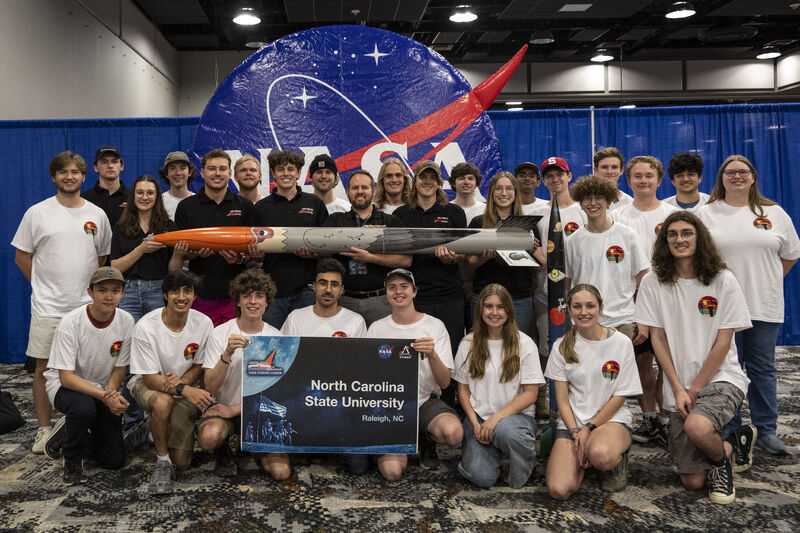
Although the UNC Charlotte 49er Rocketry Team did not place, “This year, the team had exceptional dynamics. The students built strong relationships and supported each other throughout the project. They maintained a positive attitude even in high-pressure situations and enjoyed spending time together outside of the project. This team spirit helped them have a memorable experience while applying their engineering knowledge to solve a challenging real-world problem”, stated Dr. Vishnu Babu, faculty advisor.
NASA Lunabotics Challenge
This year’s Lunabotics challenge was to design and build a rover capable of traversing simulated lunar terrain and excavating regolith to construct a berm, which is a raised barrier or shelf at the top of bottom of a slope.
This year the team from UNC-Charlotte focused on improving the rover’s ability to excavate, contain, and deposit the regolith. This included redesigning the drum drive system to give more reliable and smoother actuation of the drum for containment and excavation. They redesigned the conveyor mechanism to bring the drive motor inside the assembly. They also remanufactured the drive wheel hubs to give a more robust connection point. Lastly, the team also focused on enhancing the rover’s autonomous capabilities. The team placed 11th Overall and achieved 6th place in the autonomy award which honors teams that successfully complete competition activities autonomously.


NASA Human Exploration Rover Challenge
Aligned with NASA’s Artemis program, this initiative provided students with hands-on experience in robotics, engineering design, and interdisciplinary problem-solving.
This year two teams from Campbell University competed in separate divisions for this challenge. The first team engaged in advanced design and analysis to construct a fully human-powered rover to meet specific NASA criteria for design and function. The second team’s primary goal was to design, build, and operate a functional remote control (RC) rover capable of navigating a complex obstacle course and performing mission-critical science tasks, including lunar vacuum sampling and terrain mapping. The team utilized advanced engineering methodologies, including CAD software, CNC machining, and 3D printing, for the rover’s development. The involvement of higher education students allows innovative and creative ideas to be implemented in the rover design. Critical thinking, problem-solving, and analytical skills are essential to researching information and practical fabrication applications, which are common workforce challenges.
For the human-powered vehicle team, addition to placing 1st out of 25 in Human-Powered College/University Division, they also received the Project Review Award and the Featherweight Award. The Project Review Award is given to college team that demonstrated the best documentation and reporting throughout the competition from proposal to design review report, to operational readiness review. From each report and presentation, the team scored highest overall for each aspect of the competition documentation.

In its inaugural year, the Human Exploration Remote Operations (HERO) team achieved remarkable success at the competition. The newly formed team brought home two prestigious awards: 2nd Place Overall and the Most Improved Award.
Student Unmanned Aerial Systems (SUAS) Competition
The national SUAS Competition challenges student teams to build unmanned aerial systems capable of autonomous tasks, obtaining information about distant objects through payload sensors.
The Aerial Robotics Club (ARC) is a student organization in the Mechanical and Aerospace Engineering Department at NC State University. The Aerial Robotics Club designs and builds aircraft from scratch to accomplish the goals of the SUAS competition, which simulates real-world applications of unmanned aircraft. The primary objective of the competition is to achieve full autonomous flight while acquiring aerial imagery of targets scattered on a large tract of land. Another major objective in the competition is to autonomously avoid virtual obstacles as well as other autonomous aircraft sharing the airspace. A new requirement this year is that the UAV must carry a payload of five water bottles and deliver them safely to targets on the ground.
“This June the Aerial Robotics Club participated in the 23st annual AUVSI SUAS competition competing against 50 other teams from across the world. Our UAS performed well and passed safety inspection quickly. The combination of our fixed-wing design and our electric engine gave our UAV the endurance and power required to fly in high wind conditions. Designing an aircraft which can fly under a wide variety of conditions is a key goal of our team and we are all proud to see our research and engineering work validated by our performance at competition this year. Unfortunately, due to an autopilot error and unsafe manual landing, our mission demonstration ended prematurely. We placed 14th in the Technical Report and 36th in the Mission Demonstration”, reported Max Shipp, the 2024-2025 ARC President and Safety Pilot.


Credit: Mark Petrilli

Credit: Mark Petrilli
American Institute of Aeronautics and Astronautics (AIAA) Design-Build-Fly
The AIAA Design-Build-Fly international competition challenges student teams to test how their aircraft execute electronic warfare missions with a burdensome pipe “antenna” on its wing.
The NC State University AIAA Design Build Fly (DBF) team designed, fabricated, and evaluated four successive UAV prototypes. Each iteration incorporated refinements to wing geometry, composite lay-up techniques, and the glider-deployment mechanism.
At the competition, NC State achieved a 30th-place finish among 110 international teams, their highest ranking in recent history. They successfully executed Mission 1 (three laps and a safe landing) and Mission 2 (three laps carrying two 16 oz “fuel” bottles plus the glider, completing the flight in under 3 minutes). During Mission 3, the aircraft unfortunately had a motor failure on the runway and was unable to takeoff, which lead to mission 3 being uncompleted as the competition ended. Another NC State first was the team’s proposal earning 1st place and their combined technical report ranking in the top 25, showing their dedication to preliminary design.
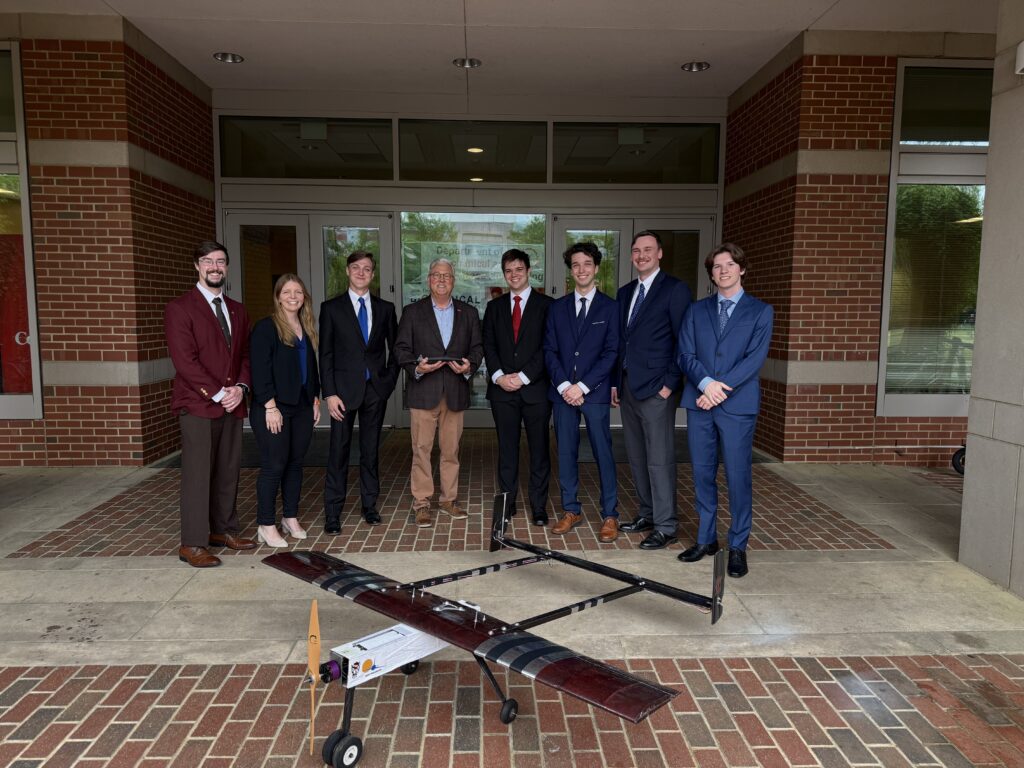


Spaceport America Cup
Spaceport America Cup 2024-25 is an international, university-level rocket competition sponsored by the Experimental Sounding Rocket Association (ESRA). College and university student rocketry teams from across the United States, and around the world compete in a specific class to fly rockets and payload with solid, liquid, or hybrid propulsion systems. Teams also are required to fly their rockets with a minimum of four-kilogram payloads to either 10,000 or 30,000 feet.
The team from Lenoir-Rhyne University again was the smallest school by enrollment in the IREC25 competition and finished better than 60% of all teams from around the world that competed in the competition. “The AeroBears always surprise other teams at competition because we are a team of fewer than 10 members. Most teams have more than triple the number of students, with some teams having more than 100 members. It truly shows the quality of work and dedication to rocketry that our members have. We have the smallest number of team members, but we consistently place higher than many larger, big-name universities.”, stated team member Kayleigh Sloop, who played roles in both avionics and social media for the team.

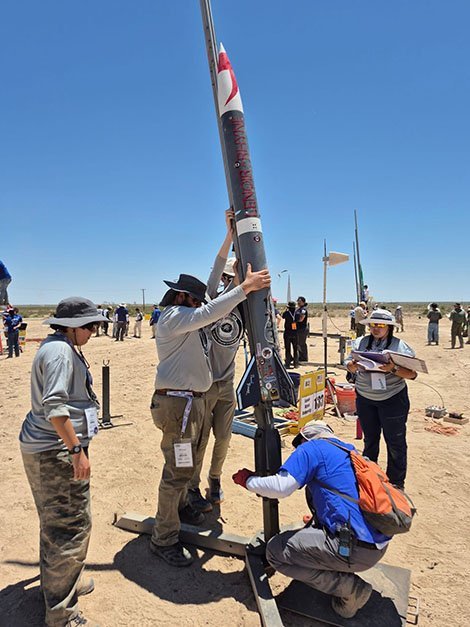

International Rocket Engineering Competition (IREC)
In partnership with the Experimental Sounding Rocket Association (ESRA), the American Institute of Aeronautics and Astronautics (AIAA) hosts an International Rocket Engineering Competition (IREC) for over 150 student rocketry teams from across the USA and around the world. With a minimum payload size of 2.2 pounds and target altitudes of either 10,000, 30,000, or 45,000 feet above ground level. Competing rockets are typically 4 to 8 inches in diameter and 8 to 20 ft. long. Multistage rockets and all chemical propulsion types (solid, liquid, and hybrid) are allowed.
Duke AERO achieved significant technical advancements and had a successful year as a club. Over 40 graduate and undergraduate students contributed to the team’s goal of designing, building, testing, and launching a high-powered sounding rocket to 30,000 feet. The team is concurrently developing solid and liquid propulsion systems, robust control schemes, and advanced manufacturing processes performed in university student shops. The team also furthered its outreach missions of providing exposure, industry connections, mentorship, and hands-on technical experiences to all high school and college students interested in aerospace.
After the academic portion of the competition, Duke AERO passed all flight safety reviews and successfully launched Perseus! The rocket exited the rail smoothly and had an excellent motor burn. A minor structural issue caused the rocket to lose stability and undershoot its target apogee, but the team recovered all components of Perseus with minor damage.
Duke AERO is consistently recognized at competitions for having advanced, complex, and well-built rockets. IREC 2025 gave students the opportunity to showcase the team’s work, learn from other collegiate rocketry teams, and connect with aerospace industry professionals. The team has already started planning for next year’s rocket and competition, while simultaneously continuing development of its liquid engine program.
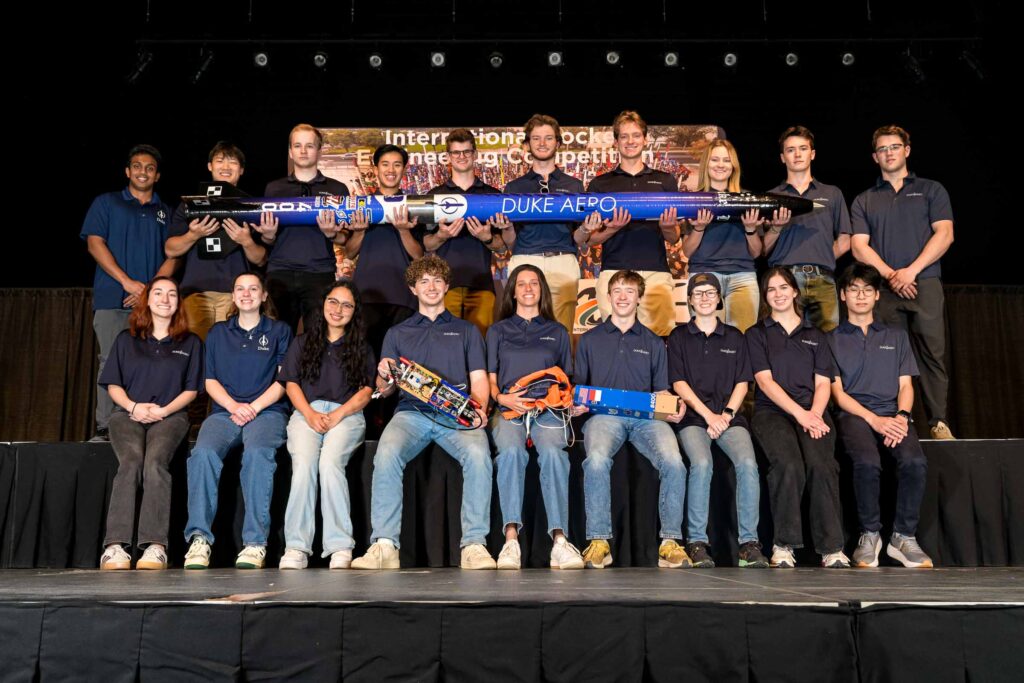
SoutheastCon 2024 Hardware Competition
The Institute of Electrical and Electronics Engineers (IEEE) Region 3 annually hosts student competitions as part of the Southeast Conference. Of these competitions, the hardware competition involves students from multi-disciplinary engineering fields working together to build and compete with fully autonomous, size-constrained robots. Robots are required to rely on self-contained mechanisms, drive bases, sensors, controllers, and navigation systems to effectively complete the field.
This year, the team from UNC-Charlotte’s design requirements dictated a robot with capabilities of manipulating astral materials. There are two types of astral materials, geodinium and nebulite. Robots score points by collecting these materials and carrying them on their robot, sorting these materials into separate bins, and then delivering these bins to specific locations on the field designated by a randomized April tag that encodes the location’s position.
The team placed 4th in the Open Competition this year. The UNC Charlotte team competed in the open competition rather than the primary university competition due to the conflict of interest surrounding the fact that UNC Charlotte was also the University hosting the competition. The main competition is restricted to only undergraduate students, whereas the open competition may have competitors ranging from high school students to graduate students and industry professionals. So, in some ways, the open competition provided stronger competition despite having fewer competitors.

RoboSub 2025
AquaPack Robotics at NC State competed in RoboSub, an international robotics competition sponsored by Robonation, the US Office of Naval Research, Naval Information Warfare Pacific, and more. The fundamental goal of the RoboSub competition is for an Autonomous Underwater Vehicle (AUV) to demonstrate its autonomy by completing underwater tasks. These tasks simulate real challenges ocean-faring AUVs might
undertake, including searching for and retrieving objects on the floor of the pool, precision dropping markers on a target location, navigating obstacles, and locating an acoustic “pinger” (sonar transmitter), much like the ones that are used to locate the “black box” on downed airplanes.
This competition cycle, their goal was to develop SeaWolf IX, a vehicle that builds on SeaWolf VIII’s capabilities to be more robust and raise our performance ceiling. Key upgrades include a modular electrical system with stackable circuit boards, wide-bandgap semiconductors, and wet-mateable connectors to increase power capacity, provide expansion space, and improve usability in the water.
Fifty-eight teams from around the world competed. The AquaPack Robotics at NC State was in 7th place after the initial design review but placed 27th after both semifinals due to a camera issue and the replacement camera being damaged. In the design documentation website, and technical documentation they placed 8th, and 11th respectively. The Team’s Design Video placed 2nd out of 58 teams. They also placed 2nd out of 58 for the Design Strategy Presentation, where the team outlined how their competition strategy developed our design rationale for robot development.


Credit: Abhi Poosarla

Credit: Abhi Poosarla
First Nations Launch
This competition is an opportunity for students attending a Tribal College or University (TCU), a Native American-Serving Nontribal Institution (NASNTI), or who are active members of an American Indian Science and Engineering Society (AISES) collegiate chapter at a non-TCU/NASNTI university/college to design, build, and fly a high-powered rocket.
The rocketry club from UNC-Pembroke had established itself as a strong competitor at several collegiate rocket competitions. This year’s team boasted several team veterans and a healthy class of first-time participants. Although the competition this year was cancelled, first-time participants were extremely excited and pleased by the design and build experience and are eager to fly to compete in a future competition. They have been actively recruiting for this coming academic year and have the largest incoming group of students in the history of the team.

- Categories:

